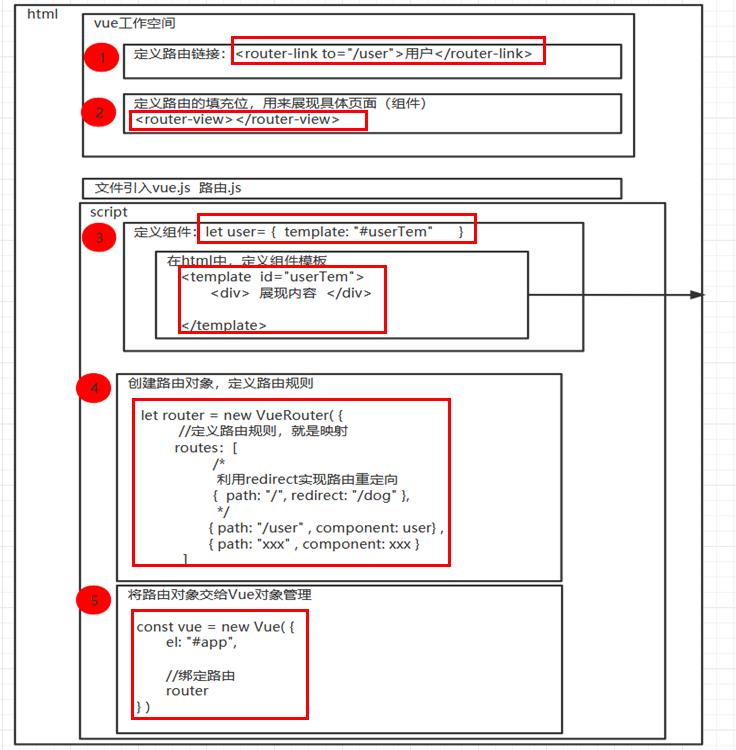vue路由步骤
Posted 江西昊仔
tags:
篇首语:本文由小常识网(cha138.com)小编为大家整理,主要介绍了vue路由步骤相关的知识,希望对你有一定的参考价值。
路由简单的理解就是—映射
1.步骤

2.原始代码
<!DOCTYPE html>
<html>
<head>
<meta charset="utf-8">
<title>Vue路由机制</title>
<body>
<div id="app">
<!-- 2.定义路由链接
router-link 解析之后,变为a标签.
to 解析之后, 变为href属性
-->
<router-link to="/user">用户</router-link>
<router-link to="/dog">狗狗</router-link>
<!-- 3.定义路由填充位 该位置用来展现具体页面(组件) -->
<router-view></router-view>
</div>
<!-- 4.2 定义组件模版 -->
<template id="userTem">
<div>
<h1>我是组件的内容!!!!!</h1>
</div>
</template>
<template id="dogTem">
<div>
<h1>养只宠物狗</h1>
</div>
</template>
<!-- 1.引入vue.js -->
<script src="https://cdn.jsdelivr.net/npm/vue@2"></script>
<!-- 1.导入路由JS 注意顺序-->
<script src="../js/vue-router.js"></script>
<script>
//4.定义组件
let user = {
//4.1定义页面
template: "#userTem"
}
let dog = {
template: "#dogTem"
}
//5.创建路由对象,定义路由规则
let router = new VueRouter({
//定义路由规则
routes: [
/*
利用redirect实现路由重定向
*/
{path: "/", redirect: "/dog"},
{path: "/user", component: user},
{path: "/dog", component: dog}
]
})
//6.将路由对象交给Vue对象管理
const vue = new Vue({
el: "#app",
//绑定路由
//router: router 名称一致时,可以简化
router
})
</script>
</body>
</html>
3.路由嵌代码
要点:映射中的children属性,写嵌套的映射。
{path: “/dog”, component: dog, children: [
{path: “/dog/samo”, component: samo},
{path: “/dog/hsq”, component: hsq}
]}
<!DOCTYPE html>
<html>
<head>
<meta charset="utf-8">
<title>Vue路由机制</title>
<body>
<div id="app">
<!-- 2.定义路由链接
router-link 解析之后,变为a标签.
to 解析之后, 变为href属性
-->
<router-link to="/user">用户</router-link>
<router-link to="/dog">狗狗</router-link>
<!-- 3.定义路由填充位 该位置用来展现具体页面(组件) -->
<router-view></router-view>
</div>
<!-- 4.2 定义组件模版 -->
<template id="userTem">
<div>
<h1>我是组件的内容!!!!!</h1>
</div>
</template>
<template id="dogTem">
<div>
<h1>养只宠物狗</h1>
<!-- 定义子组件路由 -->
<router-link to="/dog/samo">萨摩耶</router-link>
<router-link to="/dog/hsq">哈士奇</router-link>
<!-- 定义子组件占位符 -->
<router-view></router-view>
</div>
</template>
<!-- 1.引入vue.js -->
<script src="https://cdn.jsdelivr.net/npm/vue@2"></script>
<!-- 1.导入路由JS 注意顺序-->
<script src="../js/vue-router.js"></script>
<script>
//4.定义组件
let user = {
//4.1定义页面
template: "#userTem"
}
let dog = {
template: "#dogTem"
}
let samo = {
template: `<h1>通体雪白的神兽</h1>`
}
let hsq = {
template: `<h1>拆家狂魔</h1>`
}
//5.创建路由对象,定义路由规则
let router = new VueRouter({
//定义路由规则
routes: [
/*
利用redirect实现路由重定向
*/
{path: "/", redirect: "/dog"},
{path: "/user", component: user},
{path: "/dog", component: dog, children: [
{path: "/dog/samo", component: samo},
{path: "/dog/hsq", component: hsq}
]},
/*该请求是/目录下的请求,所以组件渲染也在根组件 */
/* {path: "/dog/samo", component: samo},
{path: "/dog/hsq", component: hsq}, */
]
})
//6.将路由对象交给Vue对象管理
const vue = new Vue({
el: "#app",
//绑定路由
//router: router 名称一致时,可以简化
router
})
</script>
</body>
</html>
以上是关于vue路由步骤的主要内容,如果未能解决你的问题,请参考以下文章